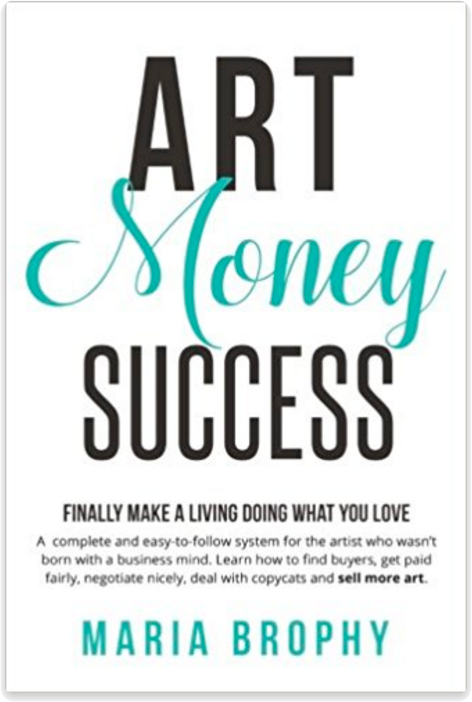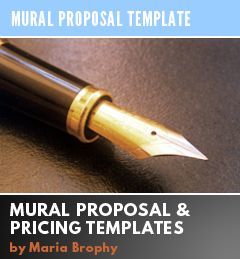An artist recently asked:
“Should I email a client a sketch for their mural, before I’m paid anything? I worry they will take it to another artist and use it. Should I send it with a contract?”
This is a great question, and there are two answers, depending on your situation.
But first, my thoughts on the concern that your client will take your sketch to another artist. Yes, this can happen. But not if you do things the right way.
If you follow my suggestions, below, for every single art commission, for the rest of your life, you will never have to worry about someone stealing your sketches.
This is because you will have a written understanding with your client and they will pay a deposit up front. The type of client that follows these business practices are not the type that will steal your art.
Below are my two answers to the question:
CURRENT SITUATION: You did the sketch work without money up front, and without a contract. You shouldn’t have. A professional artist will begin the sketch work after coming to an agreement with their client, and have received a deposit (See the “IDEAL SCENARIO below”).
But now that you’re in this situation, let’s make it right. Here’s how:
1 – SEND THE CLIENT A PROPOSAL by email that can serve as an agreement (it can be a simple one-page document). It should list the price of the mural or commissioned piece, what is included in that price, and a statement that all rights to the sketch and artwork will remain in the name of the artist – for example, it could read like this:
“Copyright: All copyrights to the art, sketches, concepts and final artwork shall forever remain in the ownership of Artist.”
2 – ASK the client to print out and sign the agreement, and send it back to you.
3 – ON YOUR SKETCH: Write your copyright notice. It can read like this:
“Artwork (c) Drew Brophy, All Rights Reserved.” This avoids any doubt that you own the copyrights to your sketch.
4 – SEND THE SKETCH to your client, After receiving their signed agreement and deposit.
*In the future, make sure you always get a written agreement and a deposit before you put a lot of work into sketches. This demonstrates commitment from the client.
(*An exception to the rule of getting a deposit paid up front: If you are brand new at this work and don’t have a portfolio, website or references that the client can check to see the work you’ve done in the past. In this case, you may have to do sketches first, to prove what you are capable of.)
Read How to Never Get Ripped off Again and How to Price a Wall Mural for more tips on pricing and payment.
IDEAL SITUATION:
The ideal scenario is to do all the right things FIRST, when working with any mural or art commission.
Below are the steps you should follow with a client, from the beginning:
1 CONVERSATION – find out what they want, what size, desired deadline, etc. Gather all the details.
2 WRITTEN QUOTE and AGREEMENT – Based on the details gathered, give them a written price quote, with a signature line at the bottom for them to sign, showing they agree with your quote. If they agree to the price quote, then they can pay the deposit and you can start the work.
If they have reservations about the price or scope of the work, then have another conversation and see how you can work it out.
3 DEPOSIT – Get a deposit before starting the work. In most cases, we get 50% up front before we start the sketch process. Some artists ask for 30%.
4 SKETCH PROCESS – Work up your sketches, send them for approval and feedback.
5 PAINTING – After the sketch is approved, you can begin the actual painting!
6 FINAL PAYMENT – Require final payment at completion. In the case of a commissioned painting, the client (often far away), will get a low res jpg image of the completed painting, by email. We ask for final payment, and upon receipt we ship the art or when they pick it up.
With murals, our contract states that final payment is due the day the mural is finished. I remind the client of this when it’s getting close to being finished, so they can get their payment ready on time.
MORE ON DEPOSITS: In the case of murals, where the price of the “commission” is very high, and the client is nervous about sending a $6,000 deposit without seeing the sketch first, we make it more comfortable for them. We ask for a smaller, non-refundable deposit to do the sketch. This amount is later deducted from the total cost of the mural.
After they approve the final sketch and want to schedule the mural painting, we get 50% of the remaining amount up front before we order the paint and put it on our calendar.
HOW MUCH SHOULD THE SKETCH DEPOSIT BE FOR A MURAL? We typically charge $1,500 for mural sketches, but sometimes more, or less, depending on the amount of work that will be involved.
The dollar amount of the deposit, however, is not as important as getting a deposit. What I mean is, even if you only get a $200 deposit, the client that pays it is a client that’s committed to the project. Money equals commitment in our society.
I have run into time-wasters out there that don’t value our time and would have Drew and me work for nothing, if we let them. This type of person is not willing to sign an agreement or pay a deposit. And that’s good, because I don’t want to work with that type of person! So, requiring these things will make those bad clients go away, and that’s what you want!
A good client, one who won’t take your sketch and hire another artist to paint it, is one who is happy to sign your agreement and pay a deposit.
This is why the deposit is your most important business tool as an artist. Watch my interview with I AM A HERO RADIO for more on this: https://www.youtube.com/watch?v=Wk96N3U7Zq4
Trust me, there are plenty of good clients out there. When you start implementing powerful business practices in your art business, you will only attract and work with good clients. The bad ones slowly disappear.
Implement the proposal process and the deposit requirement in your business, and watch how everything runs smoothly! You will see a huge, positive shift in the ease of running your business.
I hope this helps you create more powerful business practices for yourself!
PLEASE, SHARE IN THE COMMENTS, how you handle commissions, and your experiences with giving sketches to clients before having an agreement or payment. I want to hear from you!
Thanks, Maria
PS: If you have an Art Business Question for me, please either email me at consulting at mariabrophy dot com or ask on my Facebook page.
PPS: In every Newsletter I send out, I include Free Artist’s Templates for Illustration Proposals, Deal Memos and other forms that you will find helpful. Sign up for my newsletter here: http://fb.me/2Xz73H31S











14 Responses
I learned this lesson the hard way – someone hired me to design a mural for them. A lot of time spent sketching and making their changes to the design. They never paid me, and they ended up hiring someone cheaper to paint the mural.
I also learned the hard way- several months ago someone commissioned me to do a painting. Because she was a friend, I did not think necessary to write an agreement. I spent many hours sketching but she could not make her mind. I stopped the process. Even the sketches are in my possession and she did not take my idea to anyone else, I did spend many hours working for free.
Beatriz, thanks for the comment. I have found that when working with friends, it’s even MORE important to communicate, up front, what the art will cost them, so there are no misunderstandings later. I hope the friendship is still intact!
Thank you Maria for your response. The friendship is intact however I dropped the project without further communicating to her how annoyed I felt at the process- by then I did not want to engage in the possibility of resuming the work.
Oh man, if only this article had been written last year. I can attest to Maria being right. I spent hours on many sketches for a friend/client who contacted me. I drove an hour to their home spent a couple hours there talking to them about it and it sounded like it was on. She even had me revise some of my sketches. I sent her an email with quote but did not ask for a down payment to do the sketches. Boy was that a costly mistake for me. She avoided contact with me for a while and then when I called her finally to ask when we can start, she had some lame excuse of that they had to buy something instead and might get back to me. Oy!
I not only didn’t get paid for that time consuming job, I had bought several books for reference material that I have not opened since. I also put a paying gig on hold that could have caused problems with the delay. Luckily, it didn’t cause a problem, but I spent a lot of time on those sketches and I could’ve been getting art ready for an art show to sell and a bunch of other things. Learned a hard lesson.
I have often wondered if she found someone else to do it cheaper, but I have not asked. I was under the impression that I would be doing it, maybe that’s why I went to the extent I did.
I later read something on some website about taxes that I cannot remember now, that said something about being able to write off some of that lost proposal cost. It was too late for me to do it at that point, but Maria do you know of such a thing?
I’m glad to have read this article now though and plan on printing it out to use in any future quotes.
Jaime, thanks for sharing your story. It’s a common theme that I hear from artists all the time, that’s why I write about this topic so often!
To answer your question about being able to write off the proposal costs: You can only write off your actual expenses (if you are operating as a business). You can’t write off time.
Call me (239)595/7107cell
This is truly a fantastic guide for us Artists,point by point you have detailed almost all aspects Maria Brophy,thanks and Good Luck to all of us,God Bless!
Where To Get cheap Red Wings jerseys free shipping
I am a very determined sketch artist.I have several sketches I would like to have noticed and if anyone is interested.please do not hesitate to email me.
Years ago, a woman on Lake Winnipesaukee told me that after having their house on the market for two years without any success, they had decided to stay and wanted me to do some murals. I spent so much time working on sketches. I made a lot of samples of different painting styles to show her as well. My husband and I had gone there and met with her and showed her what I had worked on. I took tons of measurements (it was a big space). She seemed quite pleased. I went home and spent much time working out how to price it based on the square footage (THAT was hard) and made a nice invoice. She then tells me they found a buyer for their home and would no longer be needing my services. Never saw a dime, of course I was stupid and unsure of myself and had never asked for a deposit for sketches. So if you are having trouble selling your house just “hire” me and you’ll find a buyer in no time.
Thank you for a really awesome blog. It was actually very helpful. I am so happy I found this
Nice to read this.Thanks for sharing.
This is an excellent example of superior writing. . I found this highly interesting, with excellent usage of better words and some fantastic points. You have made a good impression on me with your interesting content and unique point of view on this subject.